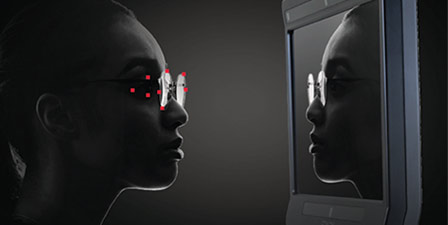
Adaptive Liquid Crystal (LC) lenses are a new option to address the near-focus decline in presbyopes due to a reduction in the crystalline lens accommodative amplitude with age. Adaptive lenses overcome the PAL limitations of small fields of view for near, and they overcome the inconvenience of a two-frame option (one for distance and one for near) for presbyopes. So, what are adaptive LC lenses, a.k.a. electronically tunable or smart lenses? Adaptive LC lenses electronically modify the properties of a medium, changing the shape of the light wavefront. Adaptive lenses are light-focusing mediums comprised of tiny cells of optical-grade liquid composed of water and oil that can change form to produce variable curvatures and focal lengths. They are referred to as liquid crystal lenses, or LC, and are made with liquid crystal technology that combines the properties of both crystalline solids and liquids. They correct refractive errors by reversibly changing the refractive index or lens shape (curvature). Their ability to adapt the focal length of light reaching the eye based on the viewing distance makes them an excellent option for presbyopes, as the lens can change power from the default distance correction to near. In its solid state, the liquid crystal molecules are held in fixed positions in regular order. When a controlled electrical current is applied, the liquid crystal molecules transform into a liquid formation, altering the refractive index and changing the focal length of light entering the eye. Liquid crystal spectacle lenses change from their default distance vision correction when a sensor on the frame temple is touched; this activates the liquid crystal section of the lens (lower nasal part) to change to the reading prescription. The source of the electrical current is a rechargeable battery on the temple tip. Electrically tunable lenses can adjust to different optical powers and therefore can be used for dynamic focus eyeglasses. When the lens is turned off, it has no optical function, and when it is turned on, it can be tuned to the required optical power.
An electric current rearranges the LC molecules to correct vision by viewing distance. Unlike PALs, which only have a small reading area at the bottom of the lens flanked by lateral distortion, LC lenses provide a full field of view. LC lenses don’t have to contend with Minkwitz distortion lateral to the small reading area of typical progressive lenses. Switching from distance to near vision requires external electronics, such as wireless technology, blink detection or proximity sensors that track eye convergence or change in pupil size during convergence.
How accurate are they? The following is an excerpt from an abstract presented at the 2023 ARVO Annual Meeting. “This study compared the power diopter obtained from liquid crystal lenses as measured by mechanical (manual) lensometer measurements. The liquid crystal lenses exhibit similar diopter power to one another at each of the settings between 0.00 to 2.50 D. The measured power was similar to the set power. The difference was not likely to be clinically significant. This suggests that the liquid crystal lenses could be a viable option for presbyopia.” (iovs.arvojournals.org/article.aspx?articleid=2787722)
We live in a time of unprecedented technological advancements, and adaptive LC lens technology could herald a new era in ophthalmic lens technology.
• Deborah Kotob
Pro to Pro Director
[email protected]












